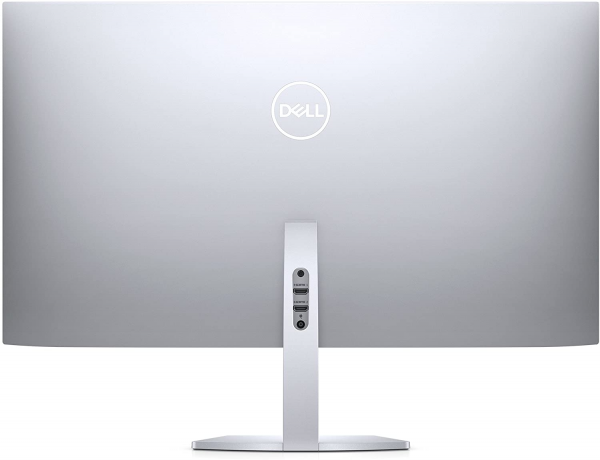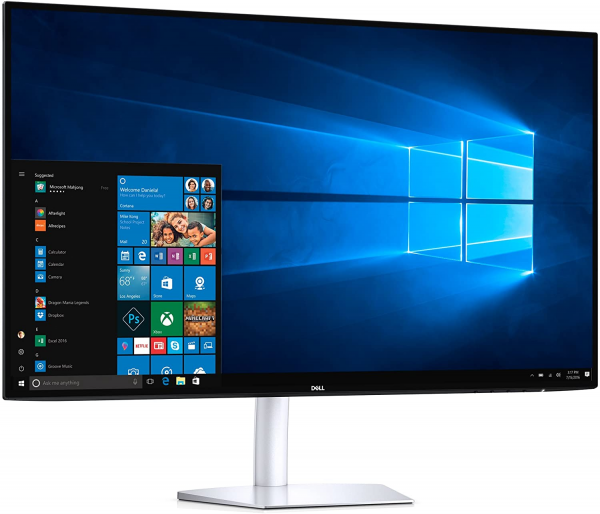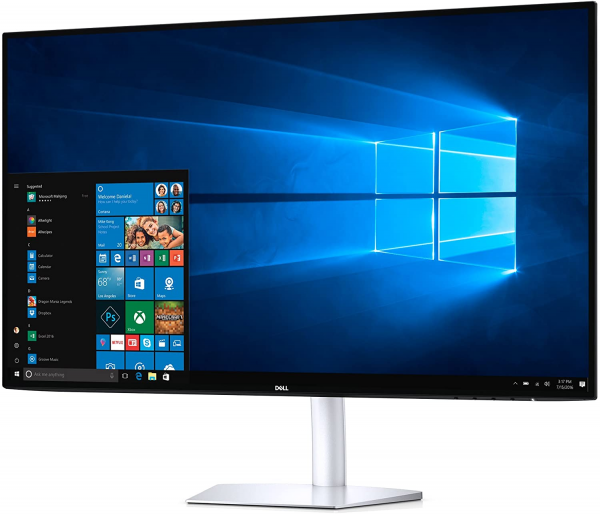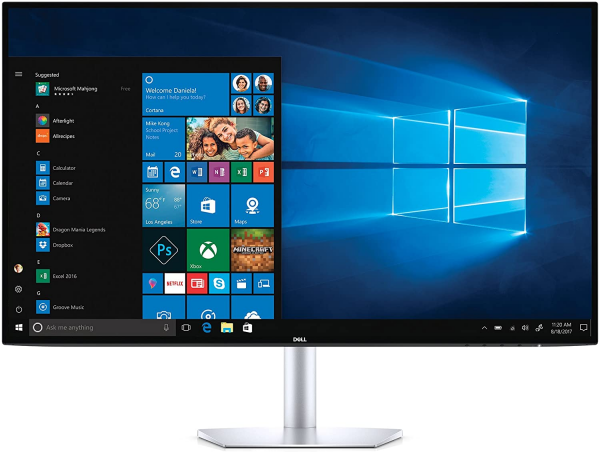Dell
Dell S2719DM: a stylish 27-inch Quad HD monitor
Aprox. 384€ - see price -
See specificationsThe Dell S2719DM monitor stands out above all for its minimalist and very refined design. It remains to be seen whether its 27-inch IPS panel displays an image worthy of its finishes ...
Positive points
Sleek design.
Exemplary finish.
FreeSync compatibility.
Open viewing angles.
Bad points
Only two HDMI inputs.
No rotation or height adjustment.
No USB ports.
Nothing to hide the cables.
Our review
Presentation
The Dell S2719DM has a 27-inch IPS panel with a Quad HD definition of 2,560 x 1,440 px. It supports a conventional refresh rate, limited to 60 Hz, compatible with FreeSync over a slightly wider range (48 to 75 Hz). The ergonomics and the connections are in the image of its design, very refined, even too much.
This screen is quite expensive for a 27 inch QHD. It is sold for around 400 € while there are very good models like the Iiyama ProLite B2783QSU for around 280 €. This is the price to put for a very beautiful design and beautiful finishes.

Ergonomics
The Dell S2719DM has a sleek design with a very rigid one-piece aluminum stand. The finishes are impeccable and the different elements are well adjusted.
Like the front, the design of the rear is extremely refined. Dell has placed the connectors in the axis of the foot to maintain a minimalist look of the most beautiful effect. The passage of cables is limited to a hole in the foot. We would have preferred a slightly more complete system to completely hide the cables, as on the BenQ GW2480.
This system is certainly elegant, but it has a major flaw: it prevents the height adjustment of the monitor as well as rotation. You just have to settle for the only tilt adjustment between -5 ° and + 20 °. However, the base of a block seems quite sturdy.
Connectivity is limited to two HDMI inputs and a headphone output. There is no DisplayPort input and Dell also skips the USB hub. Finally, the screen does not carry speakers. So you have to go through a PC speaker kit.
The extreme thinness of the product forced Dell to place the power outside, one less for the integration, but one more for the repair in case of failure of the block. The size of this food remains contained.
The five buttons on the front panel allow you to turn on the screen and access the settings. This system is not the most practical and handling errors are frequent. Fortunately, the menus are clear and the proposed settings are numerous (brightness, contrast, blue light filter, overdrive ...).
On a standard desk (140 x 60 cm), the Dell S2719DM takes up very little space thanks to a very compact stand whose depth does not exceed 16 cm.
We have measured consumption at around 24 watts with a white set at 150 cd / m². Relative consumption thus reaches 119 W / m². This is much more than the average of the last screens tested (100 W / m²) and this monitor is not really an example on this point.

Colors and contrast
Default: average gray temperature: 6.030 K
Default: gamma curve at 2.3
Default: Average Delta E at 2.8
By default, the Dell S2718D displays a fairly well calibrated image. The temperature curve is fairly stable, but the average measured at 6,030 K is a little far from the 6,500 K reference. This results in a slightly too hot rendering. The gamma curve lacks stability. Its average is 2.3, fairly close to the reference 2.2, but the light gray is slightly clogged. Finally, the average Delta E is good (2.8), but the green, red and blue are above 4. Remember that the eye perceives the difference in colors when the Delta E is greater than 3.
Manual adjustment: average gray temperature: 6.030 K
Manual adjustment: gamma curve at 2.3
Manual setting: Average Delta E at 2.8
By lowering the brightness to 23, we obtain a white at 150 cd / m² on our test pattern. The decrease in brightness does not change the behavior of the screen, which always offers the same rendering. The screen offers many other display modes, but none offers better rendering by default than the standard mode used here.
Calibrated: average gray temperature: 6,580 K
Calibrated: gamma curve at 2.2
Calibrated: Average Delta E at 2.1
As often, calibration with the probe stabilizes the gamma and temperature curves. The latter dates back to an average of 6,580 K, much closer to the reference 6,500 K. The gamma is perfectly stable on the reference value (2.2). Finally, the average delta E goes to 2.1, but the red, green and blue remain above 3. Our color profile can be downloaded by following this link.
Measured at 1040: 1, the contrast ratio of this IPS panel is average. Most IPS monitors exceed the rate of 1000: 1 and some models, notably in PLS (Philips 276E7), sometimes do better (1300: 1). As with all IPS monitors, blacks lack depth. This has no impact when used in daylight, but in the dark, blacks appear gray. For better contrast, you should turn to monitors using a VA panel, such as the AOC Q3279VWF, whose contrast exceeds a ratio of 3000: 1.
We measured the average difference in brightness uniformity at only 11% over the entire 27-inch panel; very good value. We did not see any clouding phenomenon on the model we tested. Finally, as always with IPS panels, the viewing angles are exemplary and there is very little variation in brightness when you are positioned at 45 ° from the display axis.

Reactivity
The Dell S2719DM does not use Pulse Width Modulation (PWM) to adjust the brightness. There is therefore no flickering when the brightness is reduced and this does not cause headaches for the most sensitive people. It also offers a blue light reduction mode called ComfortView.
The Dell S2719DM is compatible with FreeSync technology which dynamically shifts the screen refresh rate to the number of images per second produced by the graphics card, in order to avoid the phenomenon of image tearing (tearing) and micro-slowdowns (stuttering). The supported frequency range is low since the FreeSync only works between 48 and 75 Hz, but it still allows to smooth the game in native definition Quad HD with a mid-range graphics card, typically when the graphics card drops below the 60 frames per second .
We measured the remanence time at 10 ms with the default overdrive setting ("Normal"). This setting reduces the ghosting effect without causing reverse ghosting, unlike what happens with an even more advanced setting ("Faster" mode). We measured the delay in display (input lag) at 10.5 ms, an excellent value. There is thus no lag between the action performed on the keyboard or the mouse and its repercussion on the screen.
Conclusion
The Dell S2719DM is a very beautiful monitor with a sleek and minimalist design that will delight fans of sobriety. Too bad Dell did not push the concept to the end by allowing to completely hide the cables. It is suitable for office use with its Quad HD definition and open viewing angles, but it is not recommended for gaming because of its high persistence or for video because of its limited contrast.
Specifications
Reviews


Beautiful design, but bad QC from the factory
My monitor came with a two dead pixels, which is normal and very possible ... but also with manufacturing defects that look like squashed gnats inside the screen. I can tolerate a few dead pixels on the corners, but not distracting blemishes dead center on the screen.
I'm returning the monitor. It's a shame, because the thing is gorgeous and artful-looking, and while the picture quality is not breathtaking, it looks better than most monitors. Games look really good in 1440p. HDR is barely noticeable, but it's better than nothing. Colors pop good.
Black levels are more on par with my Acer GN246HL TN monitor, though. Backlight bleed is all over the place, the worst I've ever seen. I expected better. I also have an entry-level Samsung S24F350FHN PLS monitor and the blacks are dark and even all over, and the viewing angles are superior.
I thought the Dell would run laps around my cheapy monitors, but the difference, other than the resolution, is not enough. I had way higher expectations. The monitor is beautiful and is very light, but it has QC issues. I'm not the only one. Read the other reviews. God bless you.
I would not recommend using this monitor with a Mac.
I purchased two of these monitors. I would not recommend using this monitor with a Mac. I tested with two different Macs (2018 Mini & 2018 MacBook Pro) and the monitor only goes into YPbPr mode and not RGB mode. When in RGB mode the image turns purple. When the Mac goes to sleep it will randomly switch modes and the image will turn purple. I spent hours talking to Dell and Apple support without any real solution. I also tried different adapters as well as different HDMI cables.
Very bright
This Monitor is very bright. Colors looked superior to my dell m6500 screen that 1920 x 1200 resolution. These are the pros and cons i had with the monitor.
pros
high quality
can do 4 with right settings (hdr on and stuff)
hdr supports (from what i was able to get was 12 but maybe that was a defect)
metal base and i think back
very thin bezel and 92% screen i believe
It has free sync and can do 75hz with hdr off.
idiots
monitor has powering on issues (i turn screen off and cant get it to show picture unless unplug and plug back in)
every time I am watching something and exit out of YouTube video or just doing something the screen goes all weird coloring but once log off it fine or if I go back in to the video and back out all good. Even switching rbg type or hdr clears it to.
Monitor crash my computer to (was perfectly fine and none of these issues on my old 1080p tv monitor).
text is not clear and some missing when choosing higher resolution.
hdr settings do not work correctly. Only reference one seems the stable one.
prob more defects I forgot to list but that all I can think off for now.
sharpness I had to turn off as it gave me eye pain and prob a head ache.
I am returning this due to defects but if some one can get better one the monitor very good one to have and very bright.
Guess I was unlucky one in the lottery.
I give pictures of what happened but they on my phone (in txt msg and not on camera lol). If pictures are needed before I return it let me know some how.
Saved a lot of money on a great monitor!
I never leave reviews, but this monitor is sweet. I bought it used and it's in mint condition and works perfectly. I bought a Phillips 1080p monitor before this and the picture quality was horrible. This monitor is super thin, very easy to move, made with high-quality materials, and has a great picture. It does kind of stink how there are no speakers, but there is an aux port and I use Bluetooth soundbar anyways. Also, it could be used for gaming, but it's not great.
Beautiful design and great performance.
Works perfectly and the bezel is small so it works great in a pair. Aesthetically pleasing as well!
Great looking monitor!
This monitor looks really really good. Bright and punchy colors. Reminds me of the screens on XPS laptops.
Undoubtedly, 5 stars
Immediate reaction was - I should not pay any attention to a negative reviews and buy Dell's U2718Q 4K monitor! After 10 months of use, I am pretty happy with my S2719DM. It looks more fresh and less boring as above mentioned 4K monitor; has a beautiful design, but unfortunately lacks useful ports. The image quality is excellent. I use it in pair with older FullHD 22 "Samsung TN panel and Dell looks stunning in comparison.
I'll enjoy working on this classy, borderless, bright, and thin monitor on my desk and, when time comes, I'll replace it with the most recent (probably ultrawide QLED) monitor.